




Oregon women’s basketball’s reliance on three key players proved to be its unraveling


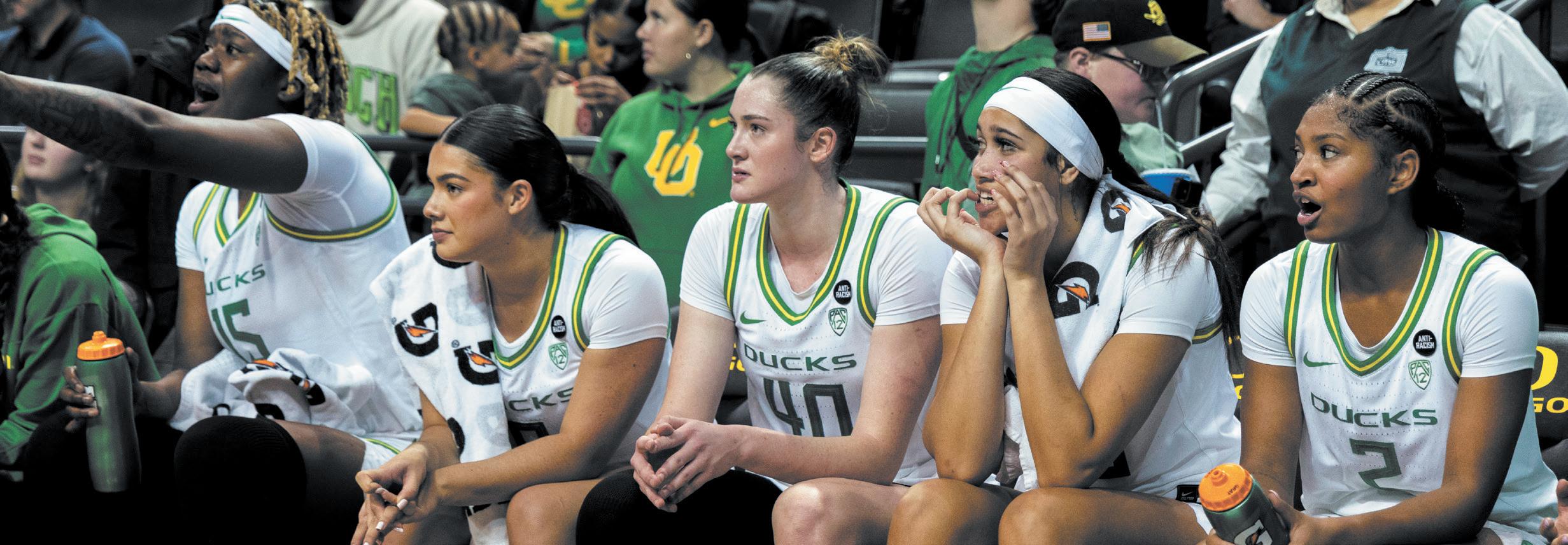
Four years ago, the Ducks were on top of the basketball world. Coming off a conference-best 31-2 record, Oregon women’s basketball was projected to be placed into the Portland Regional as a No. 1 seed.
That changed with the cancellation of the NCAA Tournament due to the COVID-19 pandemic.
Flash forward to 2024, and Portland is once again hosting a regional in the tournament. This time, the Ducks will be sitting at home.
The return of college basketball’s biggest tournament in the state of Oregon is a stark reminder of how far the team has fallen in a matter of a few years.
This season — just like in 2020 — has been a historic one for Oregon women’s basketball. This time around, it’s not the good kind of historic. The Ducks rounded out the season with 14 straight losses, the worst streak in program history. They only recorded two wins in the entirety of Pac-12 play and had an overall record of 11-21.
“We’re struggling this year. Everybody knows it,” Oregon head coach Kelly Graves said after a February loss to UCLA. “We’re the ones that have set the bar and we haven’t reached our own. The bar was set in the last 10 years.”
Prior to the start of Graves’ tenure, an 11-21 record would’ve been pretty typical for this program. As Graves pointed out after the regular season, the Ducks only won five NCAA Tournament games in
their history before he took over in 2014. They’ve won 12 since.
Graves and his Oregon squad seemed bound to take it a step further in the 2020 season. The Ducks had already cut a couple of nets from winning the Pac-12 regular season and Pac-12 Tournament and they had their eyes set on cutting down a couple more.
Everything appeared to line up perfectly for Oregon that year. It proved itself by making its first Final Four the previous season. It had both the future No. 1 and No. 2 picks in the WNBA Draft, Sabrina Ionescu and Satou Sabally, as well as the dominant power forward Ruthy Hebard. With a regional being hosted just a couple hours north in Portland, the Ducks had a good shot at making its second straight Final Four.
But things didn’t end up working out as neatly as anticipated. Oregon’s season — and the illustrious careers of several of its greatest players — ended following the Pac-12 Tournament.
“It appears our ‘unfinished business’ will remain just that,” Graves said on X, formerly known as Twitter, in March 2020. “Disappointed but I completely understand.”
The cancellation of the 2020 NCAA Tournament didn’t just crush the dreams of Oregon fans. It signified a crashing halt in the Ducks’ Pac-12 reign.
Oregon made the NCAA Tournament in the next two seasons after 2020. Its exits came sooner and sooner before finally missing out on
the tournament completely in 2023. The Ducks’ 2024 season will once again be done following their appearance in the Pac-12 Tournament, preventing them from making the trip to Portland. This season, it won’t be a global pandemic stopping them. Instead, it’s their shortcomings.
“We’ve had a pretty good run here,” Graves said after the team’s last regular season loss against Stanford. “I don’t think that run’s over, but it’s been a difficult season.”
Between blowout losses and only two conference wins, this program has plummeted from the top of the Pac-12 to the bottom. Graves is still adamant that Oregon can return to the powerhouse it once was. To do that, he says it will require recruiting and retaining its best players — something it has struggled to do in recent years.
While the Ducks tumbled from their peak quickly, some programs have also returned to their peak just as fast. Take Oregon State, for example, which went from 11th in the Pac-12 last season to now No. 13 nationally. Graves seems to believe his team can do the same thing.
In 2030, it will mark 10 years since the season that left a hole in the hearts of Oregon fans. It will also indicate the first time that Portland will host the Women’s Final Four. The last four years proved to the Ducks how hard it is to stay at the top. The next six will determine whether or not their time there was a fluke.
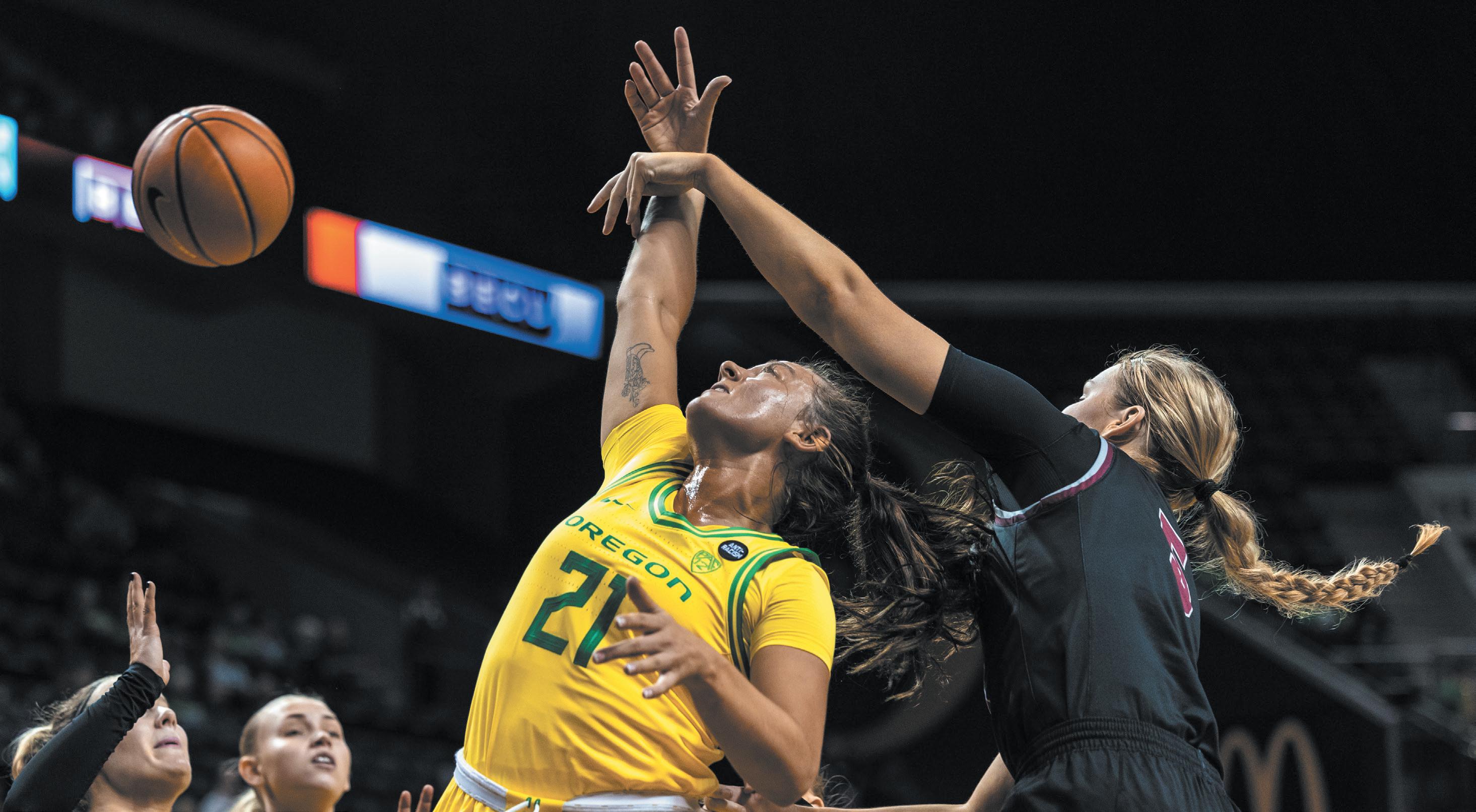
In her lone season with Oregon women’s basketball, Bella Hamel showed that being a Duck goes well beyond what is displayed on the court
On Jan. 26, 2023, the Oregon Ducks’ women’s basketball program secured a commitment from Lane Community College’s most promising prospect: a defensive stalwart from its backyard that led Lane to its sixth NWAC title.
But that is not where Bella Hamel’s journey to Eugene began.
Growing up in Hillsboro, Ore., Hamel has always been a Ducks fan.
“I’ve been watching the Oregon Ducks my whole entire life, so the fact that I get to represent them and wear the uniform is really empowering,” Hamel said.
While at Liberty High School, Hamel started to build her resume as a workhorse and was named Pacific Conference Defensive Player of the Year. She also cemented her name as a Class 6A All-State selection.
Receiving little interest, notably from her beloved Ducks, Hamel decided to take her talents to Lane County in a different way.
About four miles from Matthew Knight Arena lies the University of Oregon’s backyard; within it, Lane Community College, where Hamel would shine in the next three years.
“Going into Lane, I was immature, I still didn’t know what I wanted, and it gave me a taste of what college basketball was like,” Hamel said. “It gave me the strength to be who I am today.”
During her time at Lane, Hamel appeared in 73 games — and started for the Titans in every single one of them. In the pandemic-impacted 2020-21 season, Hamel was named to the all-region team, the all-freshman team and the all-defensive team.
She dazzled again in the 2021-22 season, her official freshman season. Hamel was named the NWAC Southern Region Freshman of the Year and was named to both the first-team and the all-defensive team.
The 2022-23 season was the culmination of all she worked for.
In her final season at Lane, Hamel proved to everyone that this was the right decision, winning the NWAC Baden Player of the Year. She averaged 18.3 points per game, 12.3 rebounds per game and shot 42.4% from three.
Hamel also led the Titans to a 32-1 record and a NWAC tournament win, Lane’s sixth-ever title.
But that wasn’t nearly the highlight of her season.
“I never thought I would get a call from a big school like Oregon,” Hamel said. “I didn’t commit on the spot, but I would’ve.”
Hamel received the call over winter break and was away from family. Keeping this hushed up from them was difficult, but telling her parents this news over the phone wouldn’t do it justice.
“I wanted to tell my parents first and then I was gonna commit … I knew once [head coach Kelly Graves] offered me, I was gonna commit,” Hamel said.
However, coming into a Division I program meant that Hamel needed to take on a different role. This season, the senior played a total of just 73 minutes, mostly in the waning moments of games that the Ducks never had a chance in.
Adapting to this role was tough for Hamel, who was a starter and go-to player in all of her three years at Lane.
What helped her the most, she said, was that her teammates were tremendously supportive of her and that she was never made to feel less important than she did at Lane.
Nonetheless, this season has been a wonder for the Hillsboro native. Oregon has been her dream school for as long as she can remember.
“I finally made it to the top, I never thought I would get here, seriously,” Hamel said. “I kinda feel like a big dog.”
What shined through about Hamel was her maturity and understanding of the “play your best five” mentality spurred by Graves, Hamel said. She has handled the transition from star player to emotional leader with grace and has been one of the loudest, most supportive voices from the bench.
As the season comes to a close and Hamel is given her flowers on senior night with her family by her side, the jumbotron will have a hard time capturing what it took for her to get to that moment.
Three years being Lane’s star and her untraditional path gave her the strength and perseverance to achieve her ultimate dream. Hamel paved the way for Titans to become Ducks and has proven that teams go much deeper than who is out there on the court every day.
“Once a Titan, always a Titan, and I really do feel that,” Hamel said.

Another disappointing season for the Oregon Ducks women’s basketball team has wound to a close. After finishing the season just 2-16 in Pac-12 play and 11-20 overall, the Ducks saw an early exit in the first round of the Pac-12 conference tournament after a loss to the No. 18 Colorado Buffaloes on Mar. 6.
“It’s been tough,” Kelly Graves, head coach of the team, said after Oregon’s loss to the Stanford Cardinal. “It’s been a tough season, all the way around. I think just kind of a perfect storm in a lot of different ways.”
Graves’ statement rings true when looking at the host of injuries the Ducks dealt with during the season. Just five minutes into her season, Peyton Scott went down with a seasonending injury. Scott, a fifth-year senior who had transferred to Oregon prior to this season, was supposed to be an offensive force who would have helped in steadying the offense with both her scoring and playmaking.
With just 10 games remaining in the season, the Ducks lost Sofia Bell, a freshman guard who had started every game, for the rest of the season as well.
Looking back through the season, what seemed to be a team that wanted to make some noise in a stacked conference ended up being a bottom feeder that finished the season with 14 consecutive losses. There was one major trend that continued throughout the season for Oregon: the lack of scoring coming from players outside of the “big three” of Grace VanSlooten, Phillipina Kyei and Chance Gray.
These three players averaged a combined 42.1 points per game this season, compared to the team’s average of 60.8 points per game. Players outside of this trio averaged just 18.7 points per game throughout the season, meaning the Ducks could never reliably count on anyone else to step up. During the 18 games of conference play, Oregon got double-digit points from someone outside of VanSlooten, Kyei and Gray just four times. Kennedy Basham had two games with at least 10 points and Ula Chamberlin and Bell had one each.
“We know who those big three are,” Graves said after a win over the Southern Jaguars earlier this season. “Everybody else has gotta kinda execute, fulfill their important roles.”
That vote of confidence in the supporting cast came at a time in the season where the Ducks sat 7-3 before the beginning of conference play. At the time, the comment seemed like a call for help. Looking back, it seems more like an omen of the reality that this team faced.
This Oregon team lacks talent, and what talent it had was hurt by key injuries at inopportune moments in the season. Despite all the factors working against them, the Ducks should not have been this bad. The offensive possessions throughout the season looked disjointed and uninspiring. It did not take long to see that Oregon was not going to be a factor in the Pac-12 this year.
Taking bad losses to teams in non-conference play, like Utah Tech, Santa Clara and University of Portland, showed the cracks in the foundation early. However, as the season progressed, those cracks became chasms. Poor 3-point shooting — just 30.0% from deep for Oregon — started to become harder and harder to account for. With no reliable threats from outside other than Gray, the Ducks struggled to play from behind the whole year. VanSlooten preferred to do her work in the mid-range and Kyei from inside the paint, which meant that more often than not Oregon had to rely on the defense to help itself back into games.
That defense, which was the main calling card for the Ducks this season, was not strong enough to overcome the offensive deficiencies. Graves ran a zone defense that was very weak on the perimeter for most games. A hot-shooting night from deep for an opponent of Oregon generally resulted in a win for that team. These cases, with the two most glaring coming in the losses to Santa Clara and Utah Tech early in the season, put the Ducks in a position to have to win with their shooting. Unfortunately for Oregon, that was not something that was easy to do.
After taking losses in bad matchups or on freak shooting nights in non-conference, the Pac-12 was a wake-up call for anyone who thought those early losses were outliers. When the competition got stiffer, the Ducks showed that they just did not have enough around their big three to compete. Oregon averaged just 56.0 points per game in conference play, 40.7 of which came from
VanSlooten, Kyei and Gray.
If there is a silver lining from this disaster of a season, it is the ages of many of the key players on the team. In addition to Scott, both Chamberlin and Kennedi Williams are seniors. However, every other player on the roster has at least one year of eligibility left. If Oregon can keep its players from entering the transfer portal, there could be a lot of familiar faces wearing green and yellow next season.
“I’m [as] disappointed as anybody,” Graves said after the loss to Stanford. “But I think, you know, we can get this back. We just got to go out and continue to recruit.”
As Graves outlines, there is a path to regaining competitiveness. That path does not yet seem to lead to contention, but after this season just being relevant would be an improvement. The 2024-25 season will see Oregon add two new recruits: point guard Katie Fiso, ranked the No. 32 prospect in ESPN’s top 100 ranking, and forward Ehi Etute.
Will these two new additions, plus whoever the Ducks manage to get in the portal, be enough to change the trajectory of the program? Only time will tell. However, the good news is that there is almost nowhere to go but up. It does not get much worse than 2-16, so Oregon will have the luxury of an almost guaranteed improvement over this season.
The reliance on the big three, whether it was by necessity or by design, was ultimately the undoing of the Ducks. Supplementing VanSlooten, Kyei and Gray, and making sure they do not leave in the portal, has to be priority number one in the off-season.
Short of a full renaissance from the team, Oregon will not make major waves in its first season in the Big Ten. However, progression for this team can come in the form of not being a team that opponents can overlook. Ending the year with 13 straight defeats put the Ducks in an unenviable position, making them seem like a free win. Changing that would be a success on its own.
This season could not end early enough for Oregon. Now that it is finally over, the look to the future begins. The Ducks cannot repeat their same mistakes from this year in the future. If Oregon wants to regain its status as a school that players flock to — rather than transfer away from — the turnaround needs to come sooner rather than later.

The 2024 NCAA Tournament is here and most of the “Conference of Champions” will be watching from home.
While the Pac-12 produced many dominant women’s basketball teams this season — and will be well-represented in the women’s tournament — the men’s side of the conference had an unimpressive year in its final season.
Arizona and Washington State are the only locks to make the tournament. Barring a deep run from Colorado and/or Utah, or an unexpected Pac-12 Tournament Champion — which earns an automatic bid to the National Tournament — it can be expected that a maximum of three Pac-12 programs will be invited to the “Big Dance.”
So, most of the conference will be at home, filling out brackets with the rest of us.
Admittedly, being a
The Oregon Ducks men’s basketball team took on the Michigan Wolverines on Dec. 2, 2023, in Eugene, Ore. (Molly McPherson/ Emerald)
Conference and earning less than three spots in a 68-team tournament is embarrassing. The Conference of Champions missed in 2024.
BY BRADY RUTH • DESIGNED BY ADALEAH CARMANBut was the Pac-12 really that bad this year? Or, did a pattern from recent football seasons carry over into hoops? Or did the Pac-12 just get ignored and did the “East Coast bias” have a say in the conference’s sufferings?
There’ve been discussions, articles written, debates and memes about Pac-12 football “eating itself.” Essentially, the thought was that the conference was full of talented teams, but they were too good and beat each other — ruining playoff hopes and national accolade aspirations. Did that happen in hoops as well?
Basketball season is obviously longer than football season, and that means considerably more conference games. Within each team’s 20game conference slate, they all lost at least four games. But, outside of the previously mentioned “locks,” every Pac-12 team suffered at least seven conference losses.

This isn’t an outrageous statistic. When looking at the Big Ten, 12 of its 14 teams have at least seven conference losses. In the Big 12, 11 of 14. In the Southeast Conference, eight of 14. And in the Atlantic Coast Conference, 13 of 15.
This statistic puts the Pac-12 right on par with these other stout conferences — which are all expected to have potentially double or triple the Pac-12’s number of NCAA Tournament teams.
Then where did the Pac-12 fall short?
How can we compare conferences and the talent they boast when the bulk of the season is conference games?
Well, we could look at the Pac-12’s nonconference record.
Surprisingly, the Pac-12 actually did pretty well when competing against other conferences.
The dozen teams’ non-conference records — Arizona (9-2), Arizona State (6-5), California (4-7), Colorado (9-2), Oregon (83), Oregon State (8-3), Stanford (5-5), USC (6-5), UCLA (5-6), Utah (9-2), Washington (8-3), Washington State (9-2) — combined for an overall record of 86-45 (.656%). That’s not bad. But it doesn’t scream
“powerhouse.” It’s certainly not good enough for a Power 5.
Unfortunately for the conference, when playing ranked non-conference games, the Pac-12 was a measly 6-11 (.353%). Arizona had half of those wins.
That’s where the conference fell short. The Pac-12 proved it can’t compete in games against legitimate opponents across the country. It was nice for the conference to have a decent nonconference record, but many of those games came against small schools that most people have never heard of. In the games that mattered, the Pac-12 fell short. And why would you fill the National Tournament with teams that have proven their inabilities to compete with the top dogs?
Was the conference bad? No. It was good. It just wasn’t good enough. It wasn’t too weak, but it wasn’t strong enough. In comparison to other Power 5 conferences, it was lacking — and the NCAA National Tournament’s bracket will reflect it. Maybe Arizona can make a run during March Madness and give the Pac-12 the glory that the other teams couldn’t earn.
And now — as the dissolution of the Pac-12 that we’ve all waited for becomes reality — ten of the conference’s dozen teams are set to join other Power 5 conferences while the Beavers and Cougars are left only with their memories of 15 combined Pac-12 Championships.
As for the other teams, it doesn’t get easier.
Arizona, Arizona State, Colorado and Utah are set to become new members of the Big 12, which boasted an incredible 147-34 (.812%) combined non-conference record.
Oregon, UCLA, USC and Washington will join the Big Ten, which had an impressive combined non-conference record of 117-37 (.760%).
California and Stanford will make the ironic and strangest move (frankly, it’s still astounding) to the Atlantic Coast Conference. The ACC had a respectable 119-46 (.721%) combined nonconference record in 2024.
Once a basketball gauntlet, the Conference of Champions fizzled out in its final year. It produced a forgettable basketball season in a time it needed to do everything it could to be remembered.




Y u g o E u g e n e S k y b o x + Y u g o E u g e n e C o u r ts i d e
2
4 B E D
H O M E S F O R
F A L L 2 0 2 4




Portland is one of the regional hosts for the best time of the year for college basketball fans –which teams will be there?
BY NINA-GRACE MONTES • DESIGNED BY RYAN EHRHARTMarch is finally here, which only means one thing — March Madness.
This season of women’s college basketball has been exciting to watch. Between Iowa’s Caitlin Clark breaking various records and the impressive freshman class, the growth of the sport has been tremendous.
With the regular season over, the stakes are even higher. Teams will find out on March 17 during Selection Sunday where their fate lies. For the Sweet 16 and Elite Eight, it’ll be in Portland this year.
The 12-member NCAA selection committee uses 14 different categories to determine and seed the 68-team bracket. The criteria includes bad losses, common opponents, competitive in losses, conference record, early performance vs. late performance, head-to-head, NET ranking — a sorting tool that measures a team quality based on a set of characteristics — non-conference record, observable component, overall record, regional rankings, significant wins and strength of schedule.
From there, the committee creates a seed list of No. 1 through 68 to ensure competitive balance of the top teams across the bracket.
Now, my only credential for this prediction is how much women’s basketball I consume. Over the course of the season, I have made my own top-25 rankings each week so it only makes sense to do so for the tournament as well. As someone who bought tickets for the Portland regional two months before the tournament started, this is something that I’ve been thinking about for a long time.
With that being said, here are my predictions for the Portland Regional.
Stanford University
The top Pac-12 ranked team, Stanford, has the conference’s fourth-leading scorer, second-leading rebounder and the nation’s leader in blocks-pergame in Cameron Brink. Brink is arguably the best
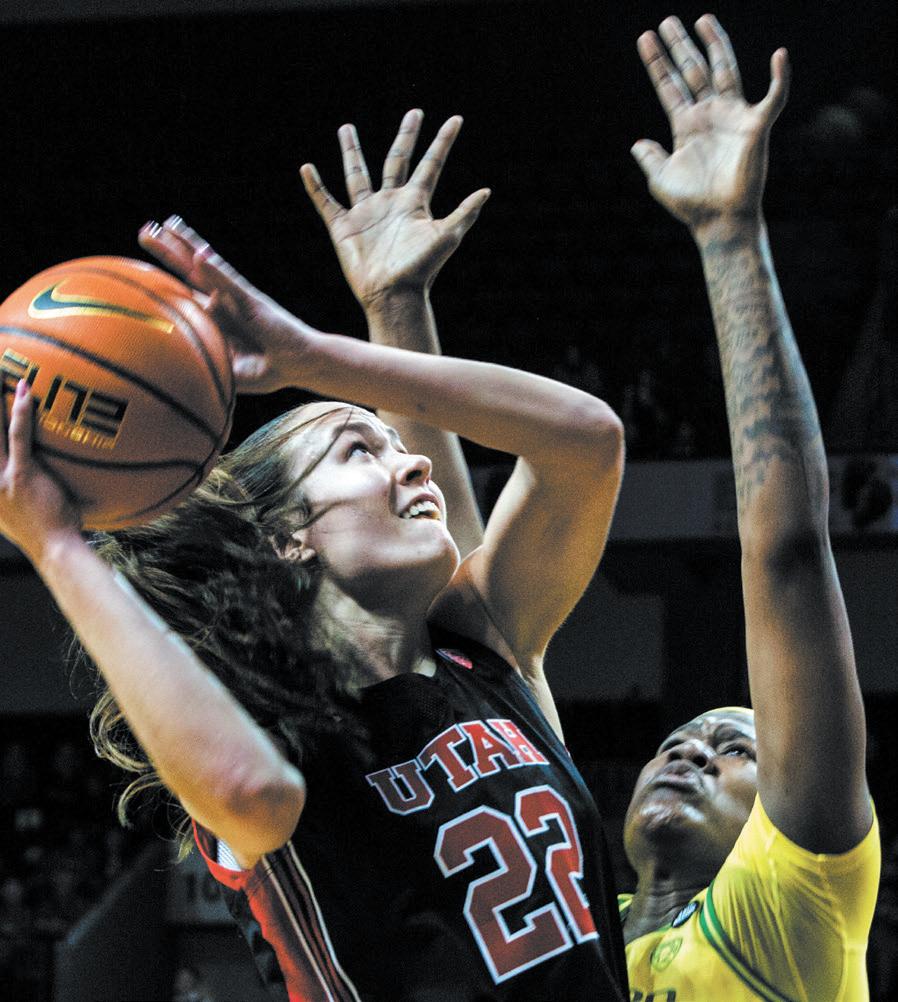
two-way big in the country and according to Her Hoop Stats, she’s the most efficient player in the nation, regardless of her position. She’s Stanford’s most valuable player and leader, which makes her the best player on the best team in the best conference in college women’s basketball.
Kansas State University
After missing last season with a knee injury and seven games this season with ankle issues, Ayoka Lee for Kansas State has been a big contributor for a team that missed the tournament last season. Recent struggles for the Wildcats have pushed them lower in the AP Rankings, but I believe they’ll be the team to sneak into Portland if Lee stays healthy.
North Carolina State University
Despite losses against UNC and Duke, NC State still holds impressive wins against then-No. 2 UConn and then-No. 3 Colorado, showing that they can compete deep into the tournament. As long as the Wolfpack’s defense stays the same in the postseason, a defense that can stop superstar scorers, they’ll make it to the Moda Center.
University of Iowa
Speaking of superstar scorers, does Clark need an introduction? The new NCAA all-time scoring leader for Iowa will be the focus of all team’s gameplans, but she’s not the only one who can score for the Hawkeyes. Hannah Stuelke scored a career-high of 47 and anyone in that lineup can have the hot hand alongside Clark, as they’ve shown over the regular season.
University of California, Los Angeles UCLA’s center Lauren Betts makes her presence known in games even if she has a quiet scoring night. Whether it’s rebounding, interior defense or steals, teams have struggled to get around Betts.
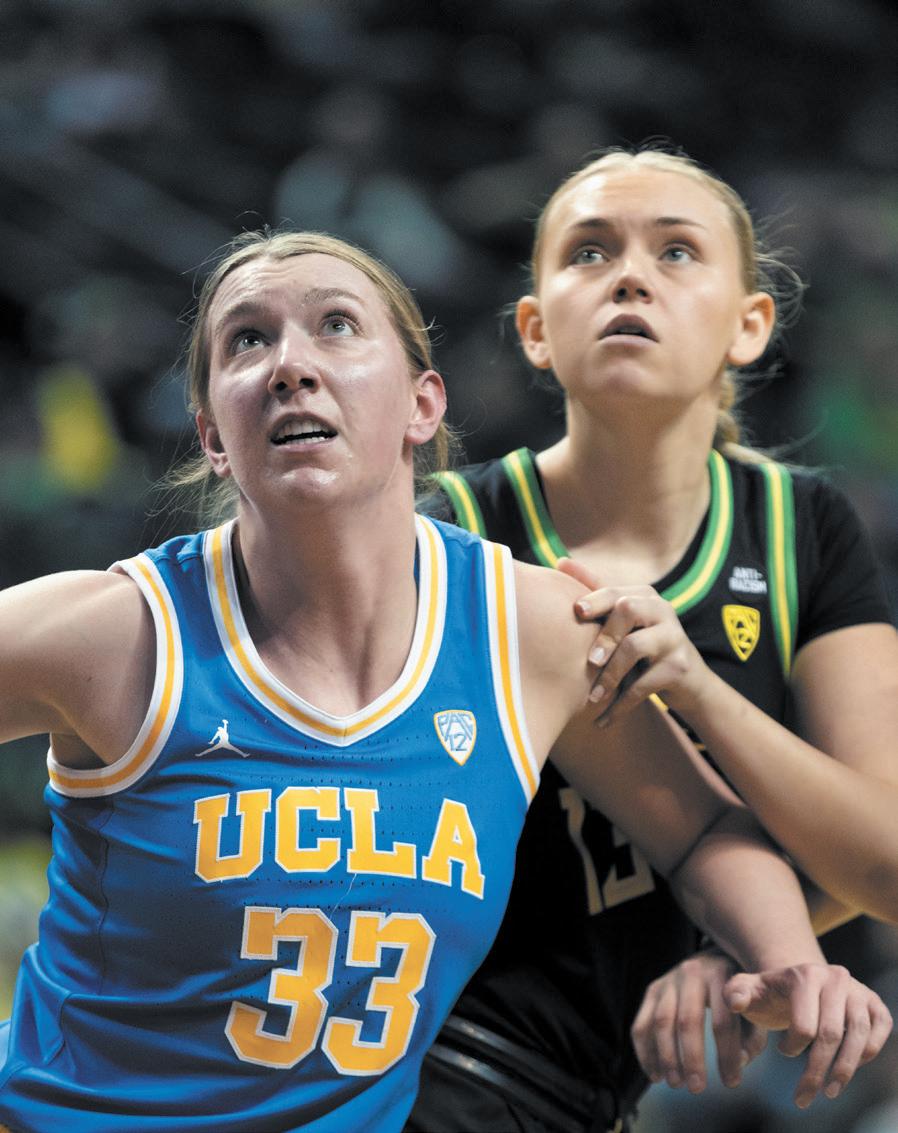
Paired with Kiki Rice, Saniya Rivers and Londynn Jones, the combination of size and shooting will give teams problems.
Notre Dame
Notre Dame has been dialed in all season. The growth that the Fighting Irish have had has been so fun to watch. The team has meshed beautifully. When freshman guard Hannah Hidalgo, who leads the nation in steals per game and third in scoring, slows down, others like Sonia Citron step up without interrupting the flow. Don’t let the Irish get into a groove, or good luck stopping them.
Oregon State University
Oregon State, technically the host of the Portland Regional, has surged through the AP poll. The Beavers had an easy non-conference schedule with only one Power Five opponent in Texas Tech, but still defeated every opponent in non-conference. Oregon State has one of the most balanced scoring attacks in the Pac-12 and a solid defense with Raegan Beers leading the show.
University of Texas
Texas lost its point guard Rori Harmon to a season-ending knee injury, which put more weight on the shoulders of freshman Madison Booker, and she responded well. Out of an impressive freshman class, Booker has been at the top of that list.
Stanford and Iowa
Between Brink’s defense and efficiency and the hot hand of Clark, teams need to be close to perfection to beat them.
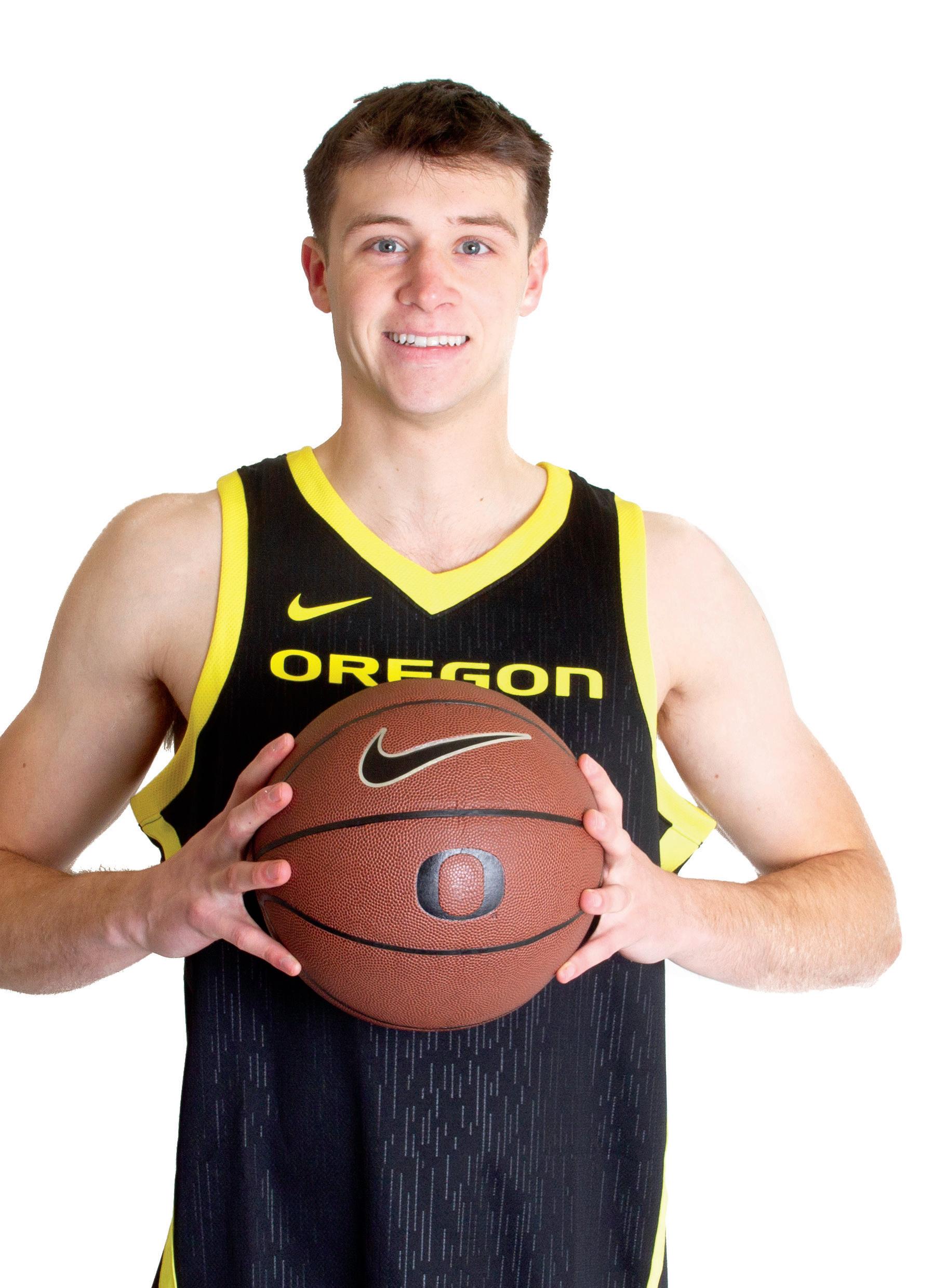

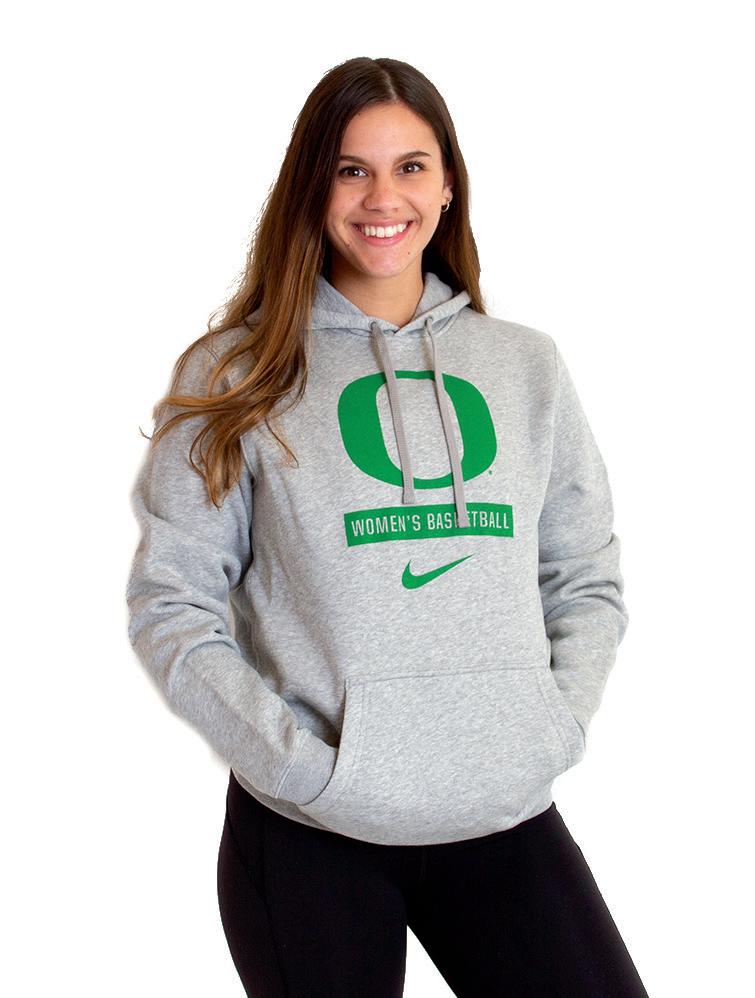
Whether you’re a forever fan, or it’s your first time cheering on our Ducks deep in the woods at Matthew Knight Arena, there’s a little something for everyone to enjoy, and The Duck Store is ready for you.